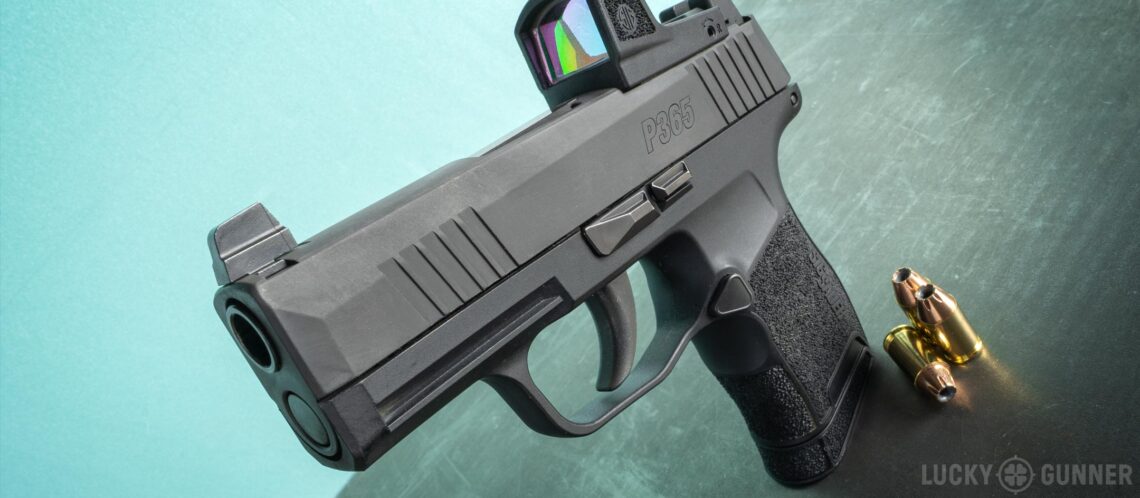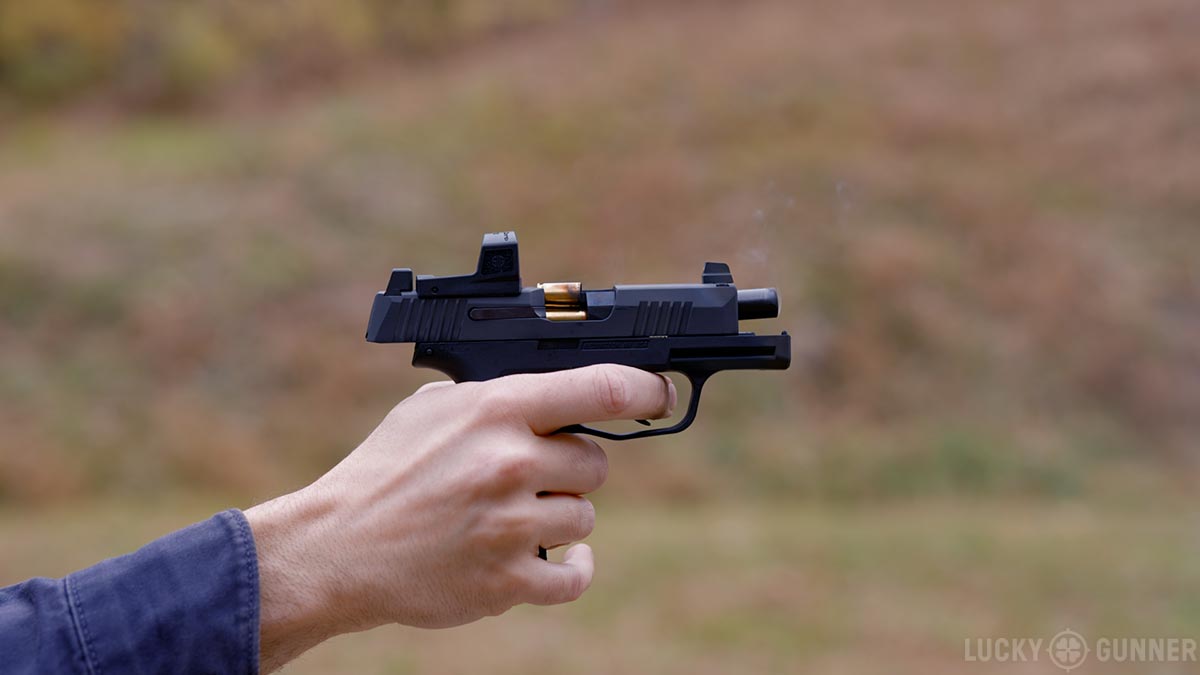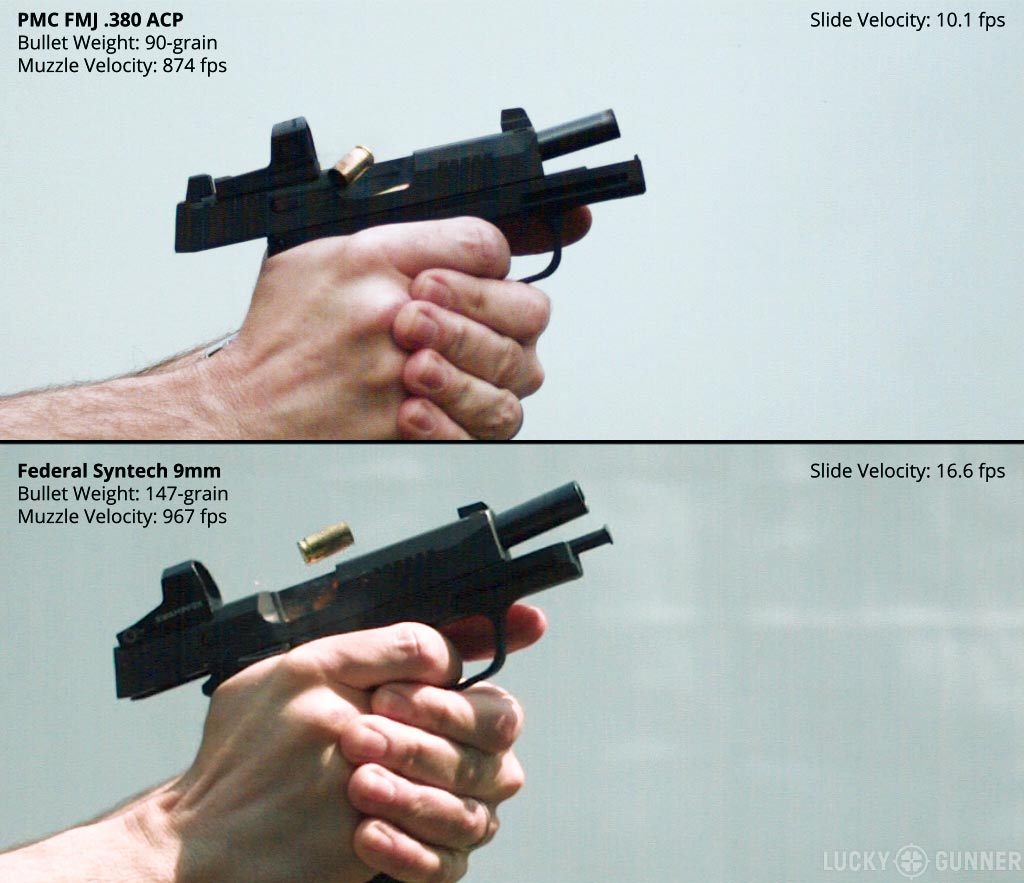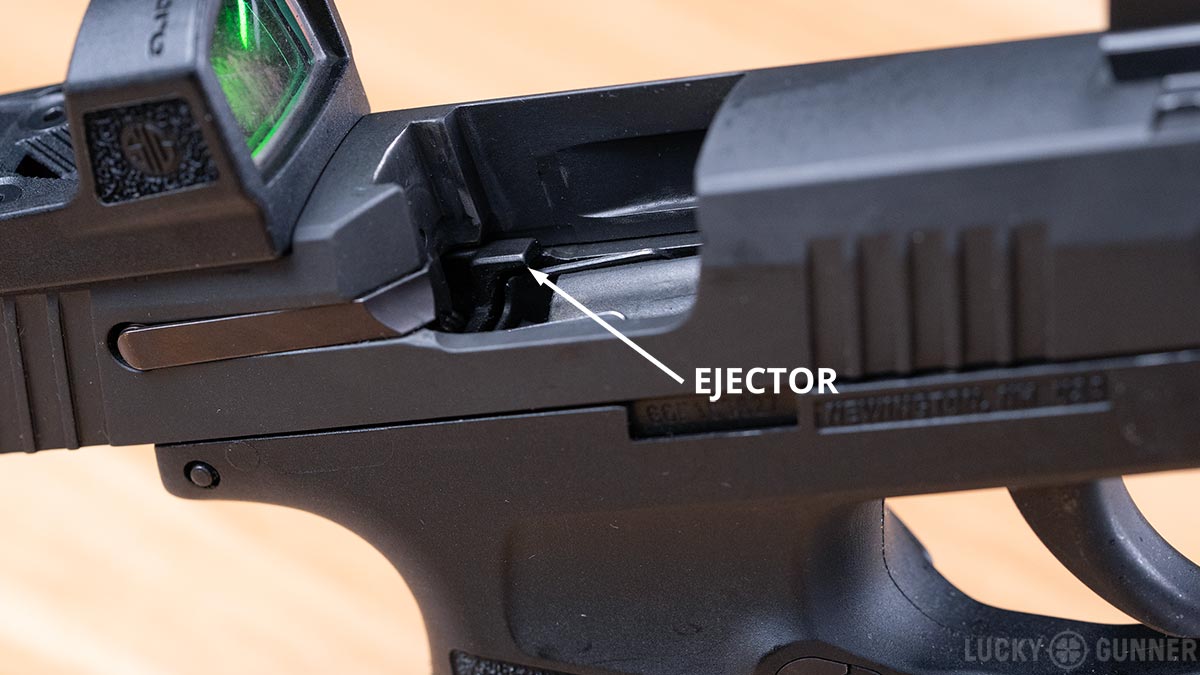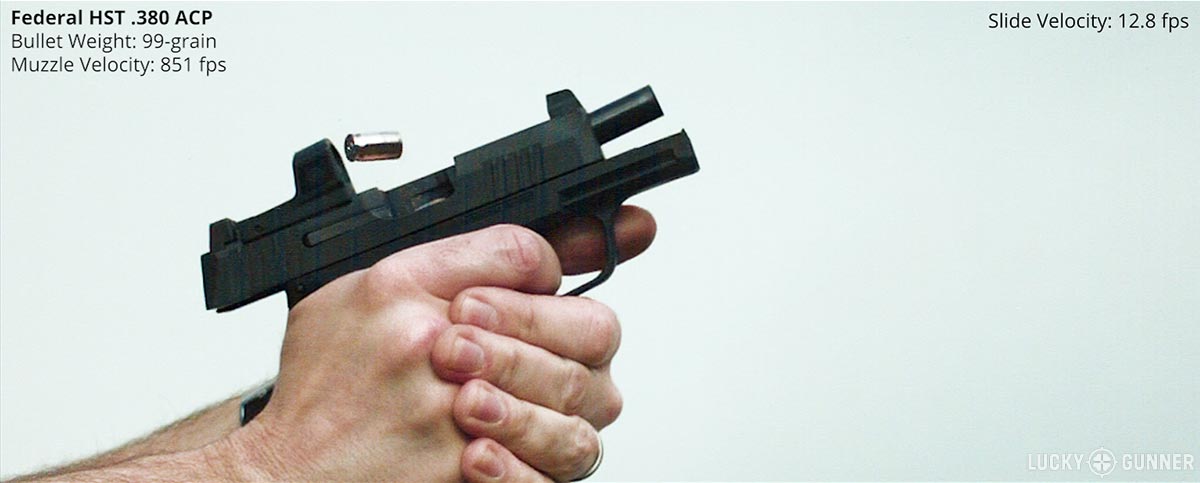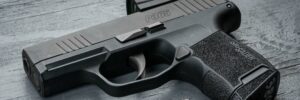The P365-380 has excellent potential as a carry gun that’s much softer shooting than its 9mm predecessor. But like a lot of .380 ACP pistols in this size class, it is prone to cycling failures. With the aid of our high-speed camera, we dig into the root cause of these failures and make an attempt to fix them.
Details are in the video below, or keep scrolling to read the full transcript. If you prefer to read rather than watch, but you still want to see the high speed footage referenced in the transcript, most of those clips can be found between 4:00 and 7:30 in the video.
Hey everybody, I am Chris Baker from LuckyGunner.com and today we are taking a second look at the .380 ACP version of the Sig P365. This is more than just a sequel to the original review of this pistol that I did last year. I’m going to use this gun along with our trusty high-speed camera to explore what it actually means when we say a gun is “ammo sensitive.”
Pros and Cons of the P365-380
The P365-380 has, so far, not matched the massive commercial success of the original 9mm version, but it’s got a lot of potential. While the two look and feel identical at first, the .380 version has a lot less recoil. I would go as far as to say that this gun in .380 is more enjoyable to shoot than any other pistol of this size on the market right now.
But like most modern .380s, the P365 is a locked-breech (aka recoil operated) design and that combination can sometimes lead to borderline reliability. The .380 cartridge just barely has enough energy to open the slide, kick out the empty case, and load the next round. If any one of a number of factors is just slightly off, the gun might start to malfunction. That could be the ammo, the shooter’s grip on the gun, lack of lubrication, or some slightly out of spec manufacturing tolerance.
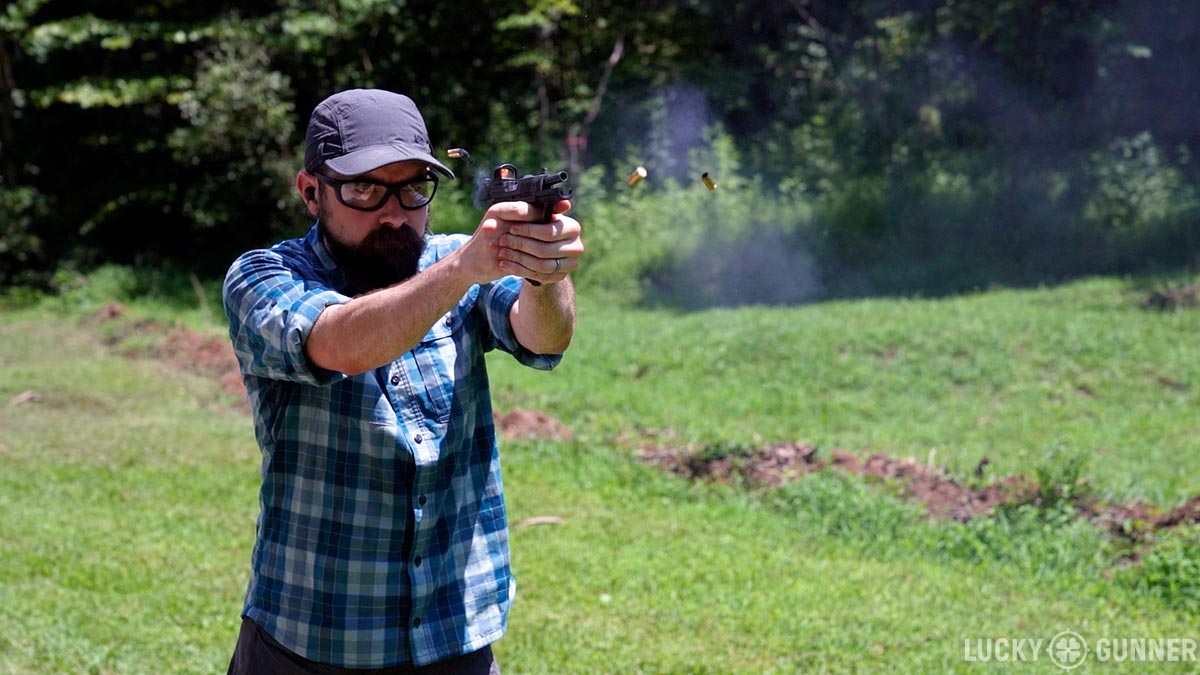
Before I reviewed this gun, I heard about several complaints from other 365-380 owners who had run into feeding stoppages they could not easily explain. When I got this one, right off the bat, I had some failures to eject with Blazer Brass. So I switched to 90-grain PMC full metal jacket, and got through 400 rounds without any trouble.
But I didn’t want to just leave it at that because I know that a lot of people are drawn to these soft-shooting .380s specifically because they have small hands or arthritis or they don’t have a ton of grip strength. They want a carry gun that doesn’t require a death grip to control the recoil. Unfortunately, without a firm grip high on the backstrap, these small .380s will often fail to cycle more readily than other pistols.
It’s also important to remember that shooting at the range under ideal conditions is not the same as shooting in a life-threatening emergency. Even a normally high-performing shooter may not always be able to get a perfect grip on the gun, depending on the circumstances.
The Loose Grip Test
Malfunctions are possible with any pistol, but I would prefer my carry gun to have a little margin for error. I don’t want it to be just on the bleeding edge of functioning properly.
So, with that in mind, for that previous review, I tried to simulate a kind of worst-case scenario and I fired the gun with a very loose two-finger grip, low down on the backstrap. I immediately started getting failures to eject once every two or three rounds.
I tried the same experiment with the 9mm P365 XL (that’s the long slide version). It cycled just fine, using everyday 147-grain range ammo. I have also tried it with the Beretta 80X Cheetah using the same PMC ammo I had in the .380 Sig. Again, no problems. That wasn’t really a surprise. The Cheetah is a straight blowback design, which tends to be a bit more reliable with .380, although with snappier recoil.
I’m sure I could eventually force these guns to malfunction if I tried long enough, but with the .380 Sig, the feeding problems were a little too easy to induce for my comfort.
High Speed Observations
So for this revisit, I wanted to take a deeper look into this reliability issue. Let’s start with some high speed footage.
This is the 90-grain PMC full metal jacket ammo that I used for most of the previous review. It seems to cycle just fine, but notice that ejection is kind of lazy. The empty case doesn’t seem to be in much of a hurry to get out of the way.
Compare that to the 9mm P365 XL. That shell ejects with some authority. There’s not an easy way to measure it, but it just looks better than the .380.
What we can measure is slide velocity. By counting frames and doing some basic math, we can calculate the velocity of the slide as it opens. The .380 slide opens at 10.1 feet per second. The 9mm is much quicker at 16.6 feet per second.
This makes sense because the faster the slide moves, the harder the case hits the ejector.
In case you’re not familiar with pistol mechanics, the ejector is this little shelf here in the frame. It’s a stationary part – it just sits there waiting for the case to run into it.
Shortly after the case is completely out of the chamber, the base of it smacks into the ejector, and that’s what makes it fly to the right and out of the ejection port. If the case doesn’t hit the ejector hard enough, you get weak ejection. Or the slide may not completely open and the case doesn’t hit the ejector at all, so it just sits there until the slide closes on it.
That’s what happens here when I fire the PMC using a loose grip on the gun. The case never makes it to the ejector and it just stays in the way. Some of the energy that would normally move the slide instead moves the frame. That effectively slows the rearward velocity of the slide from 10.1 feet per second to 7.6 feet per second.
So for this gun, when we hit a threshold somewhere between 7 and 10 feet per second, we’re going from weak ejection to no ejection. But if we use ammo with a little more energy behind it we can improve the ejection for both a strong and weak grip.
And remember, our bad grip here is not just a bad grip – it’s a substitute for any other type of problem that might keep the gun from cycling properly like an extra dirty chamber, a worn out recoil spring, or a bad magazine. It could even be something like the optic adding too much weight to the slide.
So let’s try a load that breaks the 1000 feet per second threshold like this 70-grain Federal Lead Free. And… that’s actually worse. Even with a solid grip, the slide velocity is just 8.7 feet per second. The ejection looks very weak. With a loose grip, it slows to 7.9 feet per second with predictable results. Off camera, I fired 20 rounds of this with a loose grip and it failed to eject 17 of those.
Bullet velocity does not necessarily translate to slide velocity. Bullet weight is also important. So let’s try a heavy-for-caliber load like this 99-grain Federal HST. The bullet velocity is only 851, which is not especially quick. But the slide velocity is 12.8 feet per second. That’s 27% faster than we got with the PMC. Ejection looks good. Even with a weak grip, the slide moves 9.2 feet per second and we still get full ejection. We are well below the slide velocity of the 9mm Sig, but it’s a definite improvement.
I tried the loose grip test with this gun for 20 rounds and it completely cycled every time. So I did another 20 rounds and it cycled those too.
Ammo Testing
So what does this mean for our P365-380? Well, it looks like we can improve reliability under sub-optimal conditions just by changing the ammo. It would be really helpful if there was a way to predict what ammo is most likely to work. If muzzle velocity is not a good predictor then maybe we could look at something like muzzle energy instead.
So I repeated the loose grip experiment with 14 different loads: 10 hollow points and four FMJ loads. I fired at least 20 rounds with each load. Long story short: if there’s an easy, straightforward way to predict which loads will cycle most reliably, I haven’t found it yet.
For this experiment, I’m actually not going to share the raw data like I typically do. For one thing, it’s really not fair to expect the pistol to run under these conditions, and just because a load does poorly when I’m barely hanging on to it, doesn’t necessarily mean that it won’t run in an emergency.
There was also no way to be sure I was gripping the pistol exactly the same way for every shot. And I didn’t clean or lube the gun in between loads, so that might have affected the results, too. I don’t want the results to get shared out of context and for people to get the impression that this is some kind of definitive reliability test.
But I did notice some obvious trends that might be useful, and I am happy to share those.
Trends and Observations
First of all, muzzle energy does not directly translate to slide velocity. I’m honestly not totally sure why. It probably has to do with variables like the burn rate of the gunpowder, or the dimensions of the case or the case wall thickness, or any number of other factors.
(EDIT: Some viewers have suggested that momentum might be a better predictor of slide velocity than muzzle energy. However, it also turns out that while low slide velocity leads to ejection failures, the inverse is not always true. Some loads with high slide velocity also had poor ejection.)
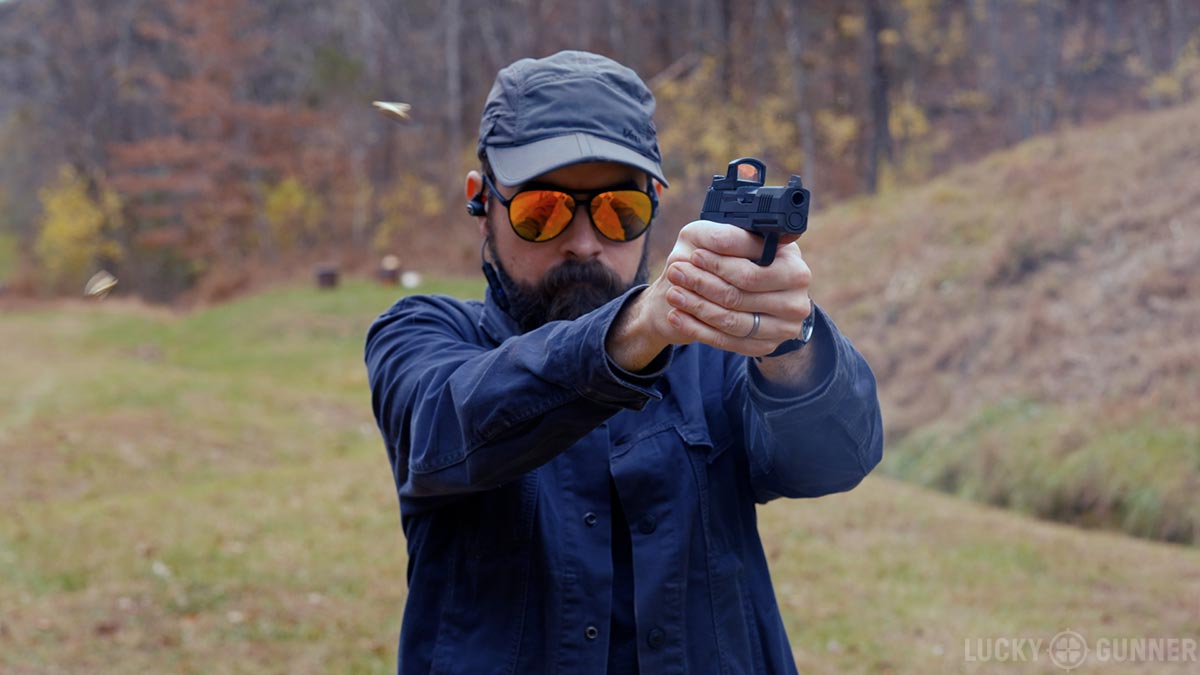
What I have noticed in the past in trying to improve marginal ejection with other guns is that heavy-for-caliber bullets generally seem to do a little better. That appears to be the case with the Sig as well. I didn’t test a ton of the lighter loads, so it’s tough to say for sure. The loads that performed best were 90 grain or heavier.
The biggest takeaway for me is that all of the hollow points cycled better than all of the FMJ loads. In the past, I know I’ve said that I generally prefer carrying full metal jacket for this caliber because .380 hollow point ballistics are pretty underwhelming. For whatever reason, this gun seems to run better with hollow points regardless of bullet weight or muzzle velocity.
The loads with more felt recoil typically performed better. They were all relatively soft-shooting loads, but there is a noticeable difference. The ejection pattern of the brass was also a pretty good indicator. Regardless of the grip, the gun kicked out the cases from the hollow points much farther and in a more predictable path than the FMJ cases.
As always, keep in mind this is a sample of one. Each of these guns is a little different and might prefer different ammo. The most important tip I can give you for ammo selection is to pick a load with availability and price that allow you to buy at least an extra hundred rounds just for reliability testing. You don’t have to do the loose grip test. Just fire it normally first and make sure it works and that it’s got a positive, consistent ejection pattern. If you want to push the limit, fire a few magazines with your off-hand with a little less grip pressure than you would normally use, and that’s probably a sufficient test.
I know it’s kind of a pain to have to spend extra time and money to vet carry gun, especially considering that there are plenty of other pistols out there that are almost guaranteed to work fine with just about any ammo you can pull off the shelf. In this case, I think it’s worth the extra effort just because of how shootable this gun is. There’s really nothing else quite like it on the market.
Guys, I had a lot of fun with this one. I hope you enjoyed it too. Have a great Thanksgiving this week and the next time you need some ammo, be sure to get it from us with lightning-fast shipping at LuckyGunner.com.
